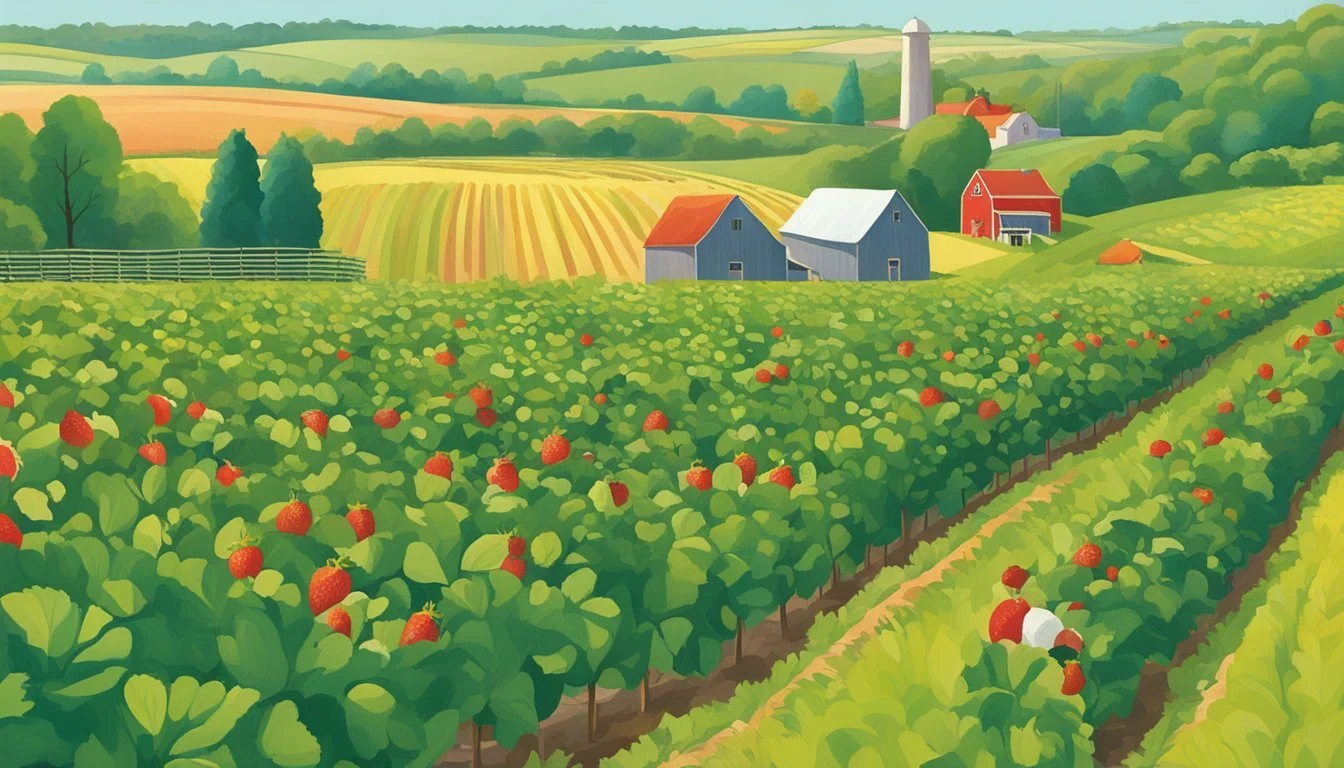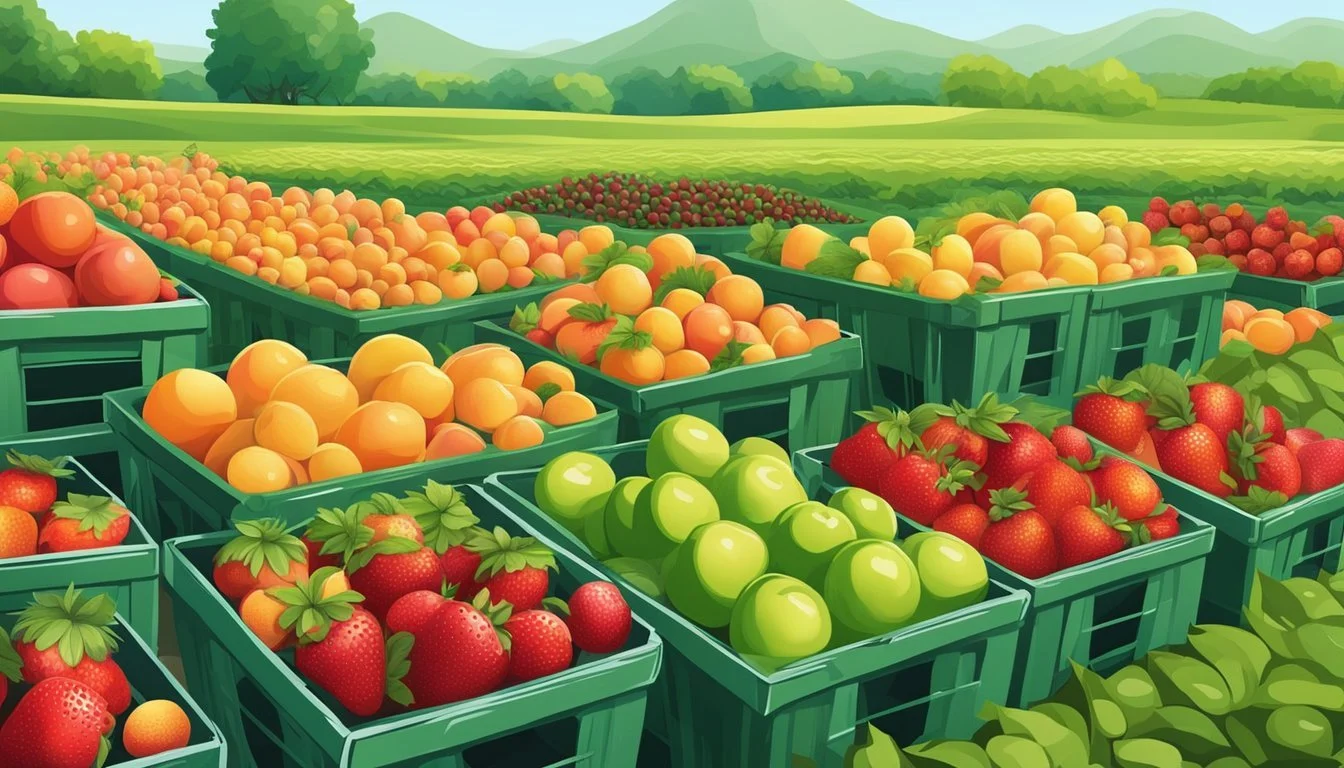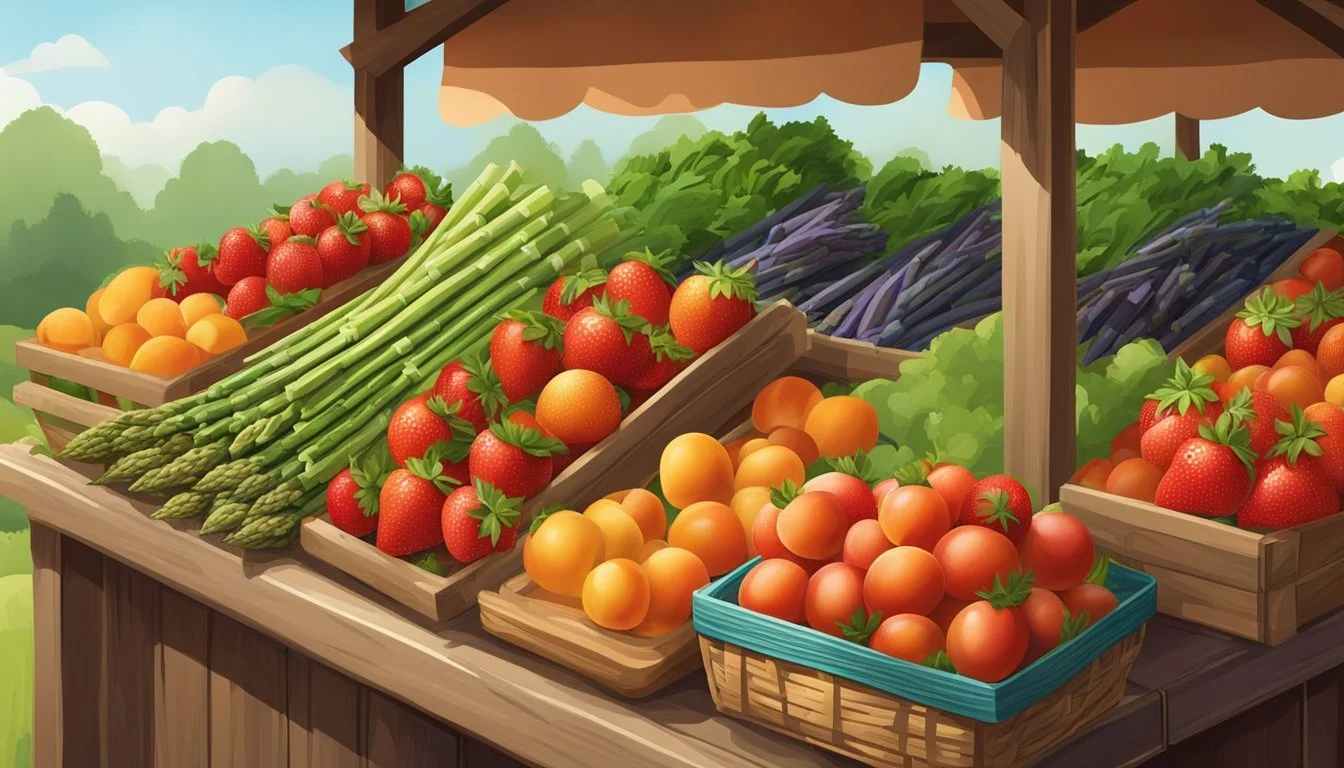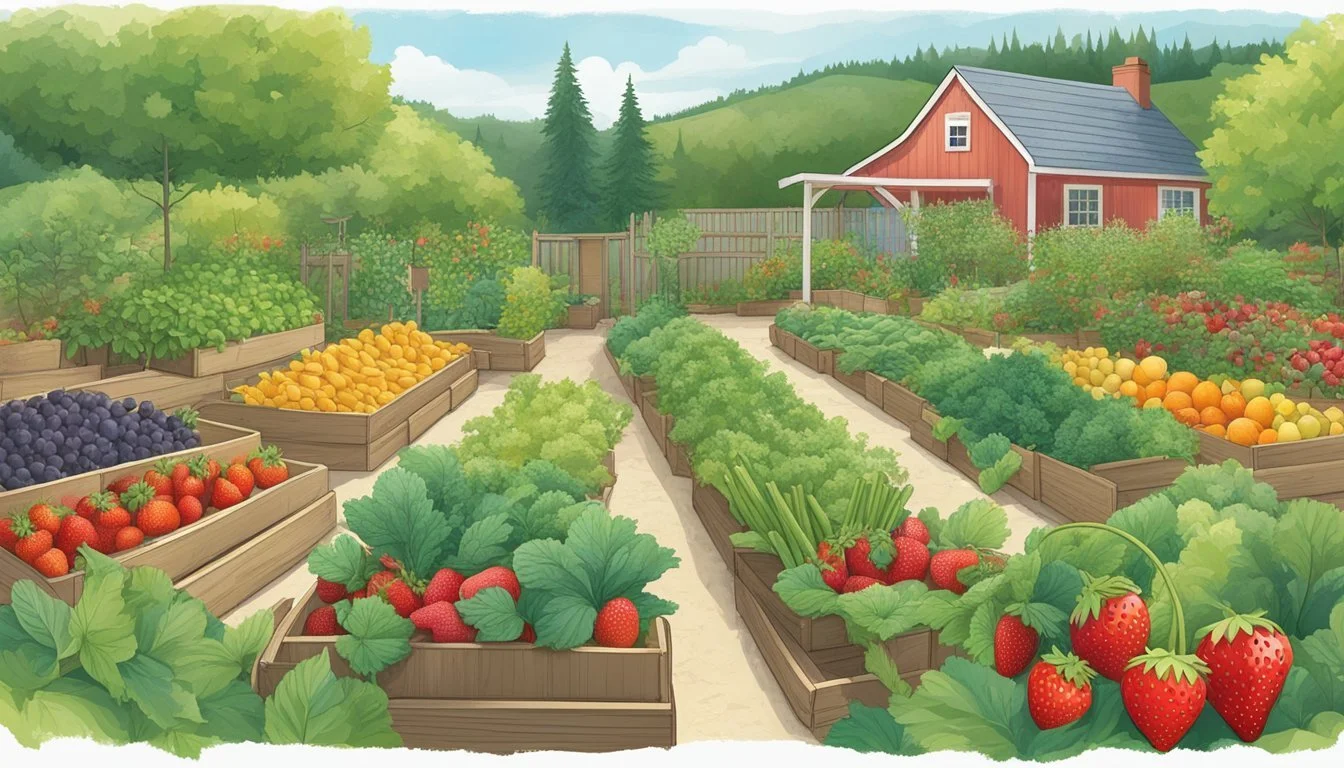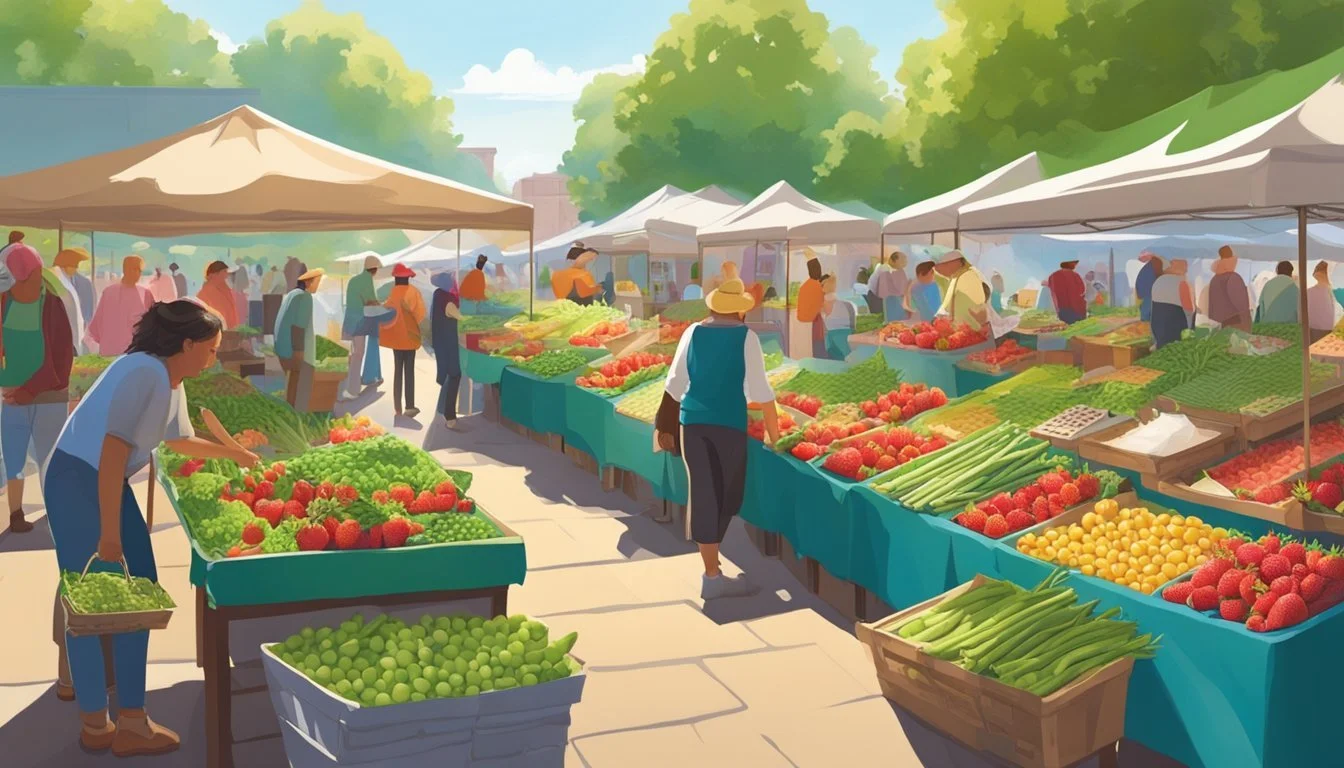Illinois Seasonal Fruit & Vegetables in May
Your Guide to Fresh Picks
This Article is Part of our Illinois Seasonal Fruit & Veg Calendar
May in Illinois heralds the arrival of spring's bounty and the beginning of the local growing season. During this month, the state's farms and gardens begin to yield an array of fresh, flavorful fruits (What wine goes well with fruit?) and vegetables, signaling a shift from the hearty root crops of winter to the tender greens and bright fruits of warmer days. Fresh produce not only brings variety and taste to the table but also provides nutritional benefits, making it a much-anticipated period for chefs and home cooks alike.
Illinoisans enjoy the harvest of cool-season crops that thrive in the mild temperatures of May. Asparagus (What wine goes well with asparagus?) spears break through the soil, ready for a short but prolific season, while leafy greens like arugula and spinach provide a base for nutritious salads. Meanwhile, the state's fruit offerings begin to hint at the summer to come, with rhubarb stalks ready for baking into pies and tangy preserves. These seasonal foods are celebrated in local markets and community-supported agriculture programs, where Illinois residents can connect directly with the source of their food and support the local economy.
Understanding Seasonality in Illinois
In Illinois, seasonality is a guiding principle for both farmers and consumers when it comes to fresh produce. The state's diverse climate zones influence the availability of various crops throughout the year. During the month of May, the rising temperatures and increased sunshine hours signal the start of a bountiful growing season.
Crop availability in May begins to widen as the risk of frost passes and the ground warms. Gardeners and farmers start to harvest the early yields of spring's labor. This seasonal shift is not just about the ability to plant, but also about peak flavor and nutritional content. Local markets become vibrant with fresh options.
A seasonal guide is invaluable for understanding what produce is fresh at this time. Here’s a concise list of some fruits and vegetables available in May in Illinois:
Vegetables:
Arugula
Asparagus
Beets
Cabbage
Lettuce
Radishes
Rhubarb
Spinach
Turnips
Fruits:
Strawberries
Each of these crops reaches its peak in freshness and flavor during May. This period is the optimal time for purchasers to seek out these items for both their taste and nutritional benefits. In doing so, consumers not only enjoy quality but also support the local economy and sustainable agriculture practices.
By adhering to a guide and understanding the ebb and flow of crop availability, those in Illinois can make informed choices that align with the state's natural production cycle. This ensures a diet rich in a variety of fresh and nutritious foods while concurrently promoting the state's agricultural heritage.
Key Fruits in Season
May marks the beginning of abundance for fruit lovers in Illinois, as the state's orchards and farms start to burst with fresh produce. At this time of year, a variety of fruits become available, offering a fresh and flavorful addition to the spring palate.
Apples
While apple harvest typically peaks in the fall, certain early varieties of apples become available in May. These apples are characterized by their crisp texture and a balance of sweet and tart flavors.
Strawberries
Strawberries are a highlight of May, coming into full swing. Rich in color and flavor, these berries are perfect for both raw consumption and culinary uses, like making jams or desserts.
Berries
Apart from strawberries, other berries such as raspberries and blackberries start to emerge in May. These berries are known for their antioxidants and are great in salads, smoothies, or as standalone snacks.
Cherries
May sees the arrival of the cherry season, when these stone fruits begin to be harvested. Cherries (how long do cherries last?)are versatile: enjoyed fresh, baked into pies, or preserved for later use.
Peaches
Peaches, although traditionally associated with summer months, sometimes see an early start in late May, depending on weather patterns. Their juicy, fragrant flesh is a clear sign of the warmer days ahead.
Nectarines
Nectarines, related to peaches but with a smooth skin, may also begin to appear at Illinois farmers markets by the end of May. They offer a slightly firmer texture than peaches but are similarly sweet.
Prominent Vegetables for May
In May, Illinois farms offer a bounty of fresh vegetables as the growing season gains momentum. Certain crops particularly thrive during this spring month, bringing flavor and nutrition to the local market.
Asparagus
Asparagus peaks in May, presenting a prime time for harvest. Gardeners carefully pick these tender spears, which are renowned for their versatility in dishes ranging from simple sautés to gourmet presentations.
Greens
A variety of greens flourish in the cool start of May. This includes leaves like spinach and varieties of lettuce, which are favored for their crisp texture and are packed with essential vitamins and minerals.
Peas
Garden peas burst onto the scene in May, signaling their readiness with plump, bright green pods. These sweet, snappy vegetables are a hit fresh from the pod, or lightly cooked to retain their delightful crunch.
Sweet Rhubarb
Rhubarb, often mistaken for fruit due to its common use in desserts, is a vegetable that reaches its sweetest stage in May. The stalks provide a tartness that complements strawberries particularly well, a classic pairing in pies and jams.
Herbs and More Exotic Options
May in Illinois brings not only an abundance of common fruits and vegetables but also a variety of herbs and more exotic options that thrive during this season. Home chefs and enthusiasts can look forward to adding fresh flavors and unique textures to their culinary creations.
Mushrooms
The warm and often moist conditions of May pave the way for a variety of mushrooms to flourish. Illinoisans can find both cultivated and wild species available in farmers' markets, with shiitake and oyster mushrooms being particularly popular. These fungi are favored for their meaty texture and versatility in dishes ranging from stir-fries to risottos.
Available Mushrooms:
Shiitake
Oyster
Morels
Morels are a seasonal delicacy eagerly anticipated by foragers and food lovers alike. These distinctive mushrooms, with their honeycomb caps, emerge in harmony with the springtime renewal of flora. They are particularly sought after for their rich, nutty flavor and are a celebrated addition to fine dining menus as well as home-cooked meals (how long do cooked meals last?).
Morel Characteristics:
Unique honeycomb appearance.
Rich, nutty flavor.
Seasonally available in May.
The hunt for wild morels can be a rewarding endeavor for those familiar with their natural woodland habitats. However, caution is advised as morels have toxic look-alikes; proper identification is crucial for safe consumption.
Locating Fresh Produce
When seeking the freshest seasonal fruits and vegetables in Illinois during May, shoppers have robust options. They can visit farmers' markets and local farms, where they will find produce like asparagus, rhubarb, and lettuces directly from the source.
Farmers' Markets
One can find farmers' markets throughout Illinois in urban, suburban, and rural settings. These markets provide a platform for local growers to offer their freshest produce directly to consumers. As per data from market associations, visiting a farmers' market during May in Illinois presents an opportunity to purchase:
Asparagus
Rhubarb
Lettuce
Spinach
Radishes
Many of these markets also host vendors selling items like honey, flowers, and handmade crafts, promoting an inclusive community atmosphere.
Local Farms
Family-run local farms operate across the state, offering a more personal experience. In May, these farms often allow visitors to buy directly from on-site stands or even pick their own produce in some cases. Seasonal availability from Illinois local farms typically includes:
Fruit: Strawberries begin to appear later in the month.
Vegetables: Greens such as kale and swiss chard, alongside root vegetables like radishes and beets.
Frequently, local farms supply fresh produce to Illinois restaurants, supporting the local economy and ensuring that diners enjoy the highest quality, seasonal flavors in their meals.
Preparation and Storage
Proper preparation and storage are crucial for maximizing the shelf life and flavor of Illinois’s seasonal produce. In May, the state offers a bounty of fresh fruits and vegetables that can be preserved through jam making and other preservation techniques.
Jam Making
Jam making is a popular method for preserving the sweetness of May’s in-season fruits such as strawberries and rhubarb. To ensure the best quality jam:
Clean the fruit thoroughly before use.
Measure ingredients accurately to maintain the proper balance between fruit, sugar, and pectin (how long does pectin last?).
Boil the mixture until it reaches the gel point, then promptly fill sterilized jars, leaving adequate headspace.
Seal the jars with two-part canning lids and process them in a boiling water bath to ensure preservation.
Vegetable Preservation
For in-season vegetables such as asparagus, peas, and radishes, proper preservation is key to extending their usability beyond the limited summer months. Techniques include:
Blanching: For vegetables like asparagus and peas, blanching followed by freezing can retain flavor and texture. Blanch for 1-2 minutes, plunge into ice water, drain, and freeze in a single layer before transferring to airtight containers.
Cool Storage: Radishes and other root vegetables can be stored in a cool, humid place. Trim the tops, clean the vegetables, and store them in perforated plastic bags in the refrigerator.
These methods allow consumers to enjoy Illinois’s May harvest well into the year.
Seasonality Chart and Guides
May in Illinois marks a vibrant period for agricultural produce, with a variety of crops becoming available across the state. This is a crucial time for consumers who prefer to incorporate fresh and seasonally appropriate produce into their diets. The availability of specific fruits and vegetables can differ based on regional climates and growing conditions; however, the following chart provides a general guide to what one might expect to find in Illinois during this month.
Fruits Availability Strawberries Early May - Available
Vegetables Availability Asparagus May - Available Rhubarb May - Available Spinach May - Available Radishes May - Available Lettuce May - Available Turnips May - Available
This data acts as an indispensable guide for both consumers and market vendors, ensuring that they are well-equipped with the knowledge of crop availability. Whether one is planning a menu, restocking produce aisles, or simply aiming for a diet that aligns with the current season, this chart serves as a reliable resource.
Furthermore, Illinois Extension services offer extensive guides on local produce, highlighting not only the availability but also providing tips on how to select and store fresh produce. These guides are tailored to give individuals a more thorough insight into making the most of Illinois' seasonal bounty.
One must note, the actual availability can be subject to change due to unforeseen weather patterns or agricultural challenges. It is always advised to check with local sources, such as farmers' markets or community-supported agriculture programs, for the most accurate and up-to-date information regarding the seasonality of fruits and vegetables.
Benefits of Eating Seasonally
Eating seasonally refers to the practice of consuming fruits and vegetables that are harvested at the time of consumption. This allows individuals to enjoy produce when it’s at its peak in both flavor and nutritional value.
Nutritional Advantages: Fruits and vegetables consumed during their appropriate seasons are often more nutrient-dense. They are typically harvested at peak ripeness, which is when they are most rich in vitamins, minerals, and antioxidants. This ensures that the consumer receives a higher level of health benefits from the foods they eat.
Environmental Impact: Seasonal eating supports sustainable agriculture. It often involves local sourcing, which reduces the long-distance transportation of produce. This, in turn, minimizes the carbon footprint and contributes to a healthier ecosystem.
Cost-Effectiveness: Seasonally available produce is more abundant, which can drive down costs. Consumers benefit from lower prices due to the increased supply and reduced transportation and storage costs.
Seasonal Variety in Diet: Integrating seasonal foods into one’s diet can introduce a diverse array of flavors and nutrients. It encourages a varied diet and helps consumers achieve a more balanced nutritional profile over the year.
Season Benefits Spring Freshness: Young and tender vegetables available Summer Hydration: Water-rich fruits in abundance Fall Satisfying: Hearty crops that store well Winter Comfort: Root vegetables for warming meals
In conclusion, eating seasonally offers nutritional benefits, supports the environment, is more cost-effective for consumers, and introduces a healthy variety to the diet.
Supporting Local Agriculture
Guiding residents to support local farms and family-run agricultural ventures is an integral step in sustaining Illinois' state economy and ensuring the availability of fresh, seasonal produce.
Community Supported Agriculture (CSA)
Community Supported Agriculture represents a significant relationship between Illinois residents and local farmers. CSAs allow consumers to purchase "shares" of a farm's harvest, often receiving a box of seasonal vegetables and fruits, along with other farm products.
How It Works: Individuals purchase a subscription from a farmer in advance.
Benefits for Consumers: Subscribers gain access to fresh, local produce, typically gathered within 24 hours of distribution.
Impact on Farms: Farmers benefit from upfront capital to manage the agricultural process, providing stability.
Families and individuals participating in CSAs receive a continuous guide through seasonal eating and become crucial stakeholders in a local farm's success. By investing in CSAs, one not only enjoys flavorful produce but strengthens the state's agricultural backbone.


